By: Elizabeth Rouse Fielder
The George Blackburn Family
Major George Blackburn Sr. (b. 16 January 1745, d. 9 September 1817) was one of the early settlers of Augusta County, Virginia. He married Prudence Berry (b. 5 November 1754, d. 14 June 1836) in Virginia on the 12th of October 1771 and moved with her to his new home in Woodford County, Kentucky, where he built Blackburn’s Fort near the Big Spring.[ii] By 1774, the fort had become the established refuge from Indian attacks for all the neighbors in the newly settled frontier.[iii] It was located near the Big Spring from which Spring Station takes its name, located on his lands that he called “Equira.”
George Blackburn built a substantial log dwelling for his family. Today, the site of the old fort is contained within the Lane’s End Farm Fort Blackburn Division on Old Frankfort Pike. Another portion of the George Blackburn land grant that shelters the second oldest Baptist Church west of the Allegheny Mountains is now owned by his descendants. The October 17, 1812 record of the Constitution of the Baptist Church of Christ at Big Spring lists George and Prudence Blackburn as founding members and that George Blackburn was called to preach to the church in 1827 after he was licensed to preach in 1824.[iv] A portion of the George Blackburn Estate has been continuously in the hands of Blackburns and their descendants since the land was granted to the Kentucky patriarch, George Blackburn in the 1770’s.
The George Blackburn Family Cemetery is currently located at 3938 Old Frankfort Pike, Midway, Kentucky, 40347 on Lane’s End Farm Fort Blackburn Division on Old Frankfort Pike (KY 1681) near the Woodford County / Franklin County line.
Elizabeth J. Blackburn, the granddaughter of George Blackburn, and wife of Dr. C. J. Blackburn, instructed her executor to “have a substantial stone wall built around my Grandfather Blackburn’s family graveyard in Woodford County and to have the graves and monuments therein repaired and put in good order, the whole not to cost exceeding one thousand dollars.” (Franklin County, Kentucky, Will Book 3, page 327).
Major George Blackburn Sr. was a disciplined soldier and a follower of Christ. He oversaw the construction of the second oldest Baptist Church west of the Alleghenies that was built on his land known as the Big Spring Baptist Church. He and Prudence had twelve children together, including George Blackburn, an eloquent minister; Dr. Flournoy Blackburn, a prominent physician; Colonel William B. Blackburn, an eminent lawyer of Versailles, representative from Woodford County in either the Kentucky house or senate continuously from 1804 to 1828, and Lieutenant Governor of the State during Governor Gabriel Slaughter’s administration; and Edward M. Blackburn (b. 10 February 1787, d. 13 March 1867), a lawyer and prominent horseman, who was born in the fort.
Edward M. Blackburn Family
Colonel Edward M. Blackburn was a patriotic and religious man like his father and a bon vivant who loved thoroughbred race horses. In fact, his thoroughbreds became legends of the new American turf. Colonel Edward M. Blackburn’s name, his horses and Equira, were known far and wide, especially when the famed racehorse and stud Lexington, who stood at Equira, rose to the very top to become the most successful stallion in history. Some of the celebrated horses raised by Colonel Blackburn or included in his stud at Equira were Boston, sire of the immortal Lexington, and Eclipse, both champions of their day and in the words of the Colonel’s son, Senator Blackburn, “not furlong sprinters, but four-milers.” Other famous horses raised by Colonel Blackburn were Blackburn’s Whip, Gray Eagle, and Buzzard Superior. Boston sired Lexington at the Blackburn Farm. Both Boston and Eclipse are buried at the farm.
Colonel Edward was known to his friends and neighbors as “Uncle Ned.” He married Lavinia Bell (b. 23 February 1794, d. 3 June 1863), the daughter of Major Bell from Culpepper County, Virginia who had settled near Pisgah in Woodford County.[v] The log home built by his father, George, was occupied by Colonel Edward Blackburn and his wife during their early married life. Edward and Lavinia’s older sons and daughters, including Luke P. Blackburn, noted physician and governor of Kentucky, were born there. Then, about 1810, Colonel Edward Blackburn built a solid colonial brick home close to the site of the first house that is now owned by Hurstland Farm Equira on Spring Station Road 3 miles west of Midway.[vi] Duty to God, country and family was paramount to Edward and Lavinia, but enjoying the thrill of racing was not far behind. Uncle Ned ‘read the law’ with George Nicholas, Lincoln’s lawyer and a well known turfman. Uncle Ned was often encouraged to run for political office, but declined, producing instead, a long line of state and national political leaders and great race horses.
Uncle Ned was famous for his thorough knowledge of horses, conversational powers, wit and gallant ability to charm his audience, particularly the ladies. Many referred to him as a regular “Lord Chesterfield,” the standard for chivalry at the time.[vii] Uncle Ned and Lavinia regularly and frequently entertained the leading politicians and turfmen of the day including such heralded Kentucky names as: John Breckenridge, (U.S. Representative: 1851-1855, U.S. Vice President: 1857-1861, U.S. Senator in 1861 until he resigned and later became the Confederate States Secretary of War in 1865); John J. Crittenden, (U.S. Senator: 1817-1819, 1835-1841, 1842-1848 and 1855-1861, U.S. Representative: 1861-1863, 17th Kentucky Governor: 1848-1850, 15th U.S. Attorney General: 1841, 22nd U.S. Attorney General: 1850-1853); and distant cousin Henry Clay, the “Great Compromiser,” (U.S. Representative and Speaker of the House: 1811-1814, 1815-1821, 1823-1825, 9th U.S. Secretary of State: 1825-1829, U.S. Senator: 1806-1807, 1810-1811, 1831-1842, 1849-1852.) It was an exciting time to live in Woodford County and play such an important part in the future of the country.
Uncle Ned Blackburn made Equira and Spring Station the epicenter for thoroughbred racing in Kentucky, where the calcium in the limestone beneath the lush grass helped to strengthen the slender legs of the thoroughbreds. Famous horse farms like Woodburn, Bosque Bonita, Nantura, Stockwood and Stonewall surrounded Equira and produced the great race horses remembered to this day.[viii] The thirteen children of Uncle Ned and Lavinia grew up surrounded by the best of the turf and the brightest political leadership in Kentucky and the U.S. They could not help but be influenced by these examples of excellence and leadership. Many took up the family practices of politics, farming and/or love of horses, and strove to be the champions in their own field.
Several of Edward and Lavinia’s children became notable political leaders in Kentucky and for the United States. Some of the accomplished children are briefly described below.
Luke Pryor Blackburn
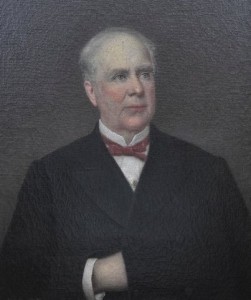
Dr. Luke Pryor Blackburn, Governor of Kentucky 1879-1883. Painting courtesy of the KHS Museum Collection
Luke Pryor Blackburn (b. 16 June 1816, d. 14 September 1887) studied at Transylvania and became a doctor in 1834. His impressive reputation was earned when he was the only doctor who remained in Versailles to fight the 1835 cholera epidemic in Woodford County until it was conquered. It was said that fifteen percent of the county population died. The grateful citizens persuaded him to stay in Versailles and in 1843 elected him to the Legislature. However, when yellow fever appeared in New Orleans in 1848, Dr. Luke Blackburn went there to fight it and established the first quarantine in the city or the Mississippi Valley. Incredibly, Dr. Luke Blackburn bought and equipped a hospital in Natchez and induced Congress to establish a Marine hospital there.[ix] Again, in 1854 he helped protect Natchez from another epidemic of yellow fever, and later fought tirelessly against the disease in Long Island, the Bermuda Islands, Memphis and in Hickman, Kentucky in 1878. During the Civil War he served with distinction as a surgeon on the staff of General Sterling Price. Grateful Kentuckians elected Dr. Luke Blackburn Governor of Kentucky from 1879 to 1883. Once in office, he fought for the rights and safety of the State Penitentiary inmates where overcrowded conditions caused diseases and death.
Today, the Blackburn Correctional Complex stands in honor of the first physician Governor of Kentucky who sought to improve the lives of inmates and assist them in reintegrating them into the community as functioning citizens. It was named for Governor Blackburn in 1970. Dr. Blackburn’s life was centered on generous humanitarian efforts.[x]
A famous race horse was named for Luke Blackburn which won 23 of its 24 starts, having only lost its first at 3. ‘Luke Blackburn’ was inducted into the National Hall of Fame in 1956.[xi]
Mary Blackburn Morris
The Edward Blackburn daughters were also quite political and married military leaders who often became political leaders. Mary Prudence Blackburn (b. 11 July 1819, d. 17 October 1884) married Judge Buckner Stith Morris (b. 19 August 1800, d. 16 December 1879) who became the first lawyer practicing in the city of Chicago and later the second Mayor of Chicago.[xii] Mary Blackburn Morris was one of the most remarkable women of her time and was known all over Kentucky and the South.
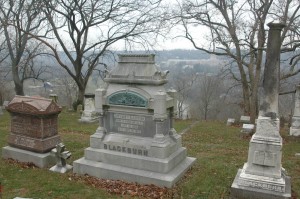
Blackburn family plot in Frankfort Cemetery, overlooking the Kentucky River and State Capitol. Photo courtesy of the author.
Elizabeth Jane Blackburn Flournoy
Elizabeth Jane Blackburn (b. 3 April 1821, d. 1860) married Thompson Breckenridge Flournoy (b. 1810, d. 2 August 1861), after his first wife, Frances Ann Blackburn Flournoy died, who was the older sister of Elizabeth. Thompson Breckenridge was a lawyer who owned a large cotton plantation in Desha County, Arkansas. He was elected to the Arkansas State Legislature in 1848 and 1850 and was chosen Speaker of the House. In 1860, he was a delegate to the Democratic National Convention in Charleston and was temporary chairman of that Convention. He was a devoted personal and political friend of Judge Stephen A. Douglas, and at the Cincinnati Convention in 1856, he labored strenuously for his nomination. Throughout the difficult scenes at Charleston and Baltimore that followed, he remained the firm and unyielding friend of Judge Douglas. Unfortunately, he died while on a trip to Kentucky. At the time of his death, he had been authorized by Confederate President Jefferson Davis to organize an Arkansas regiment for Confederate service. He was a prewar militia general, a very prominent Arkansas politician and undoubtedly would have been one of the first generals from Arkansas had he not died in 1861. His monument in the Frankfort Cemetery next to the Blackburns identifies him as “General Thompson B. Flournoy, C.S.A.”
James Weir Blackburn
Another son of Uncle Ned, James W. Blackburn (b. 30 April 1834, d. 14 December 1915), became Secretary of State and served while his older brother was Governor. James Blackburn had been a Confederate Captain in the Civil War, then Kentucky Secretary of State , and in 1885 was appointed the Revenue Collector for the District. In 1890 he was a member of the state constitutional convention. In 1906, he went to Washington D.C., to serve as secretary to his younger brother, Joseph C. S. Blackburn (b. 1 October 1838, d. 12 September 1918). His sons, Judge Samuel Blackburn and James W. Blackburn, Jr., would serve as district judges in Panama. Judge Samuel Blackburn served from 1907 to 1918 and James W. Blackburn, Jr. served in 1918 thanks to the support of their brother, Joseph C. S. Blackburn, Governor of the Panama Canal Zone, 1907-1909.
One of the more colorful historical acts signed by Governor Luke P. Blackburn and Secretary of State James W. Blackburn was the 1883 pardon for Ms. Belle Breezing, Lexington’s famous Madam, for “Keeping a Bawdy House,” in Lexington.
Joseph Clay Stiles Blackburn
Joseph C. S. Blackburn (b. 1 October 1838, d. 12 September 1918) became a lawyer in 1859 and stood his first case in the U.S. Court in Chicago against the leading counsel of the Chicago bar, Isaac N. Arnold, who would later become known as a biographer of Abraham Lincoln. As Senator Blackburn told the story one night to the Times-Star reporter, James Tandy Ellis, in the old Capitol Hotel at Frankfort:
“I was a very young man, beginning the practice of law, and for the first time, I was appearing in a United States court in Chicago. The opposing counsel was Isaac N. Arnold, one of the most distinguished men of Chicago. When the case was reached I was so nervous that I became bewildered and made only a feeble effort. I was about to sit down and let the case go by default, as it were, when a tall, homely, loose-jointed man sitting in the bar, whom I had noticed giving close attention to the case, arose and addressed the court in behalf of the position I had assumed in my feeble argument, making the points so clear that when he closed the court sustained my demurrer.
“I didn’t know who my volunteer friend was, but Mr. Arnold got up and attempted to rebuke him for interfering in the matter, when I, for the first time, heard that he was Abraham Lincoln of Springfield.
“Mr. Lincoln, in his good-natured reply to Mr. Arnold’s strictures on his interference, said that he claimed the privilege of giving a young Kentucky lawyer from the State of his birth a boost when struggling with his first case, especially if he was pitted against an experienced practitioner.
“Of course, I thanked him, and departed the court as proud as a young field marshal. I never saw Mr. Lincoln again, and he probably never recalled the young struggling lawyer that he so kindly assisted and rescued from defeat in his maiden effort before a United States tribunal.”[xiii]
Joseph Blackburn practiced law for 2 years in Chicago and then returned to Kentucky to pursue his first love: politics – by working the presidential campaign of John Cabell Breckenridge, a family friend. Breckenridge lost, and then the Civil War broke out. Joseph returned to Kentucky and enlisted in the Confederate cause, rising to the rank of Captain, and fought with distinction in the September 1863 Battle of Chickamauga. Later he became Lieutenant Colonel and was given an independent command of a Cavalry Battalion in the District of Mississippi. After the War, he returned to Woodford County again and practiced law in Versailles. In 1871, Joseph Blackburn was elected to the Kentucky House of Representatives and served two terms until 1875. Then he was elected a U.S. Representative for Kentucky from 1875 to 1885, and then U.S. Senator from 1885 to 1897. In 1896, he was nominated for the Democratic Party’s candidate for President of the United States. Senator Blackburn was elected to the U.S. Senate again from 1901 to 1907. In 1907, he served as the Democratic Minority Leader. His portrait hangs in the U.S. Capitol with all of the other prior minority leaders. His life was spent in service to his state and country.
When he went to the Senate for the first time, his certificate was signed by his brothers, Governor Dr. Luke P. Blackburn, and Secretary of State James W. Blackburn. After his third term ended, President Theodore Roosevelt appointed Senator Blackburn as the first Civil Governor of the Panama Canal Zone in 1907. Senator/Governor Blackburn served under President Theodore Roosevelt’s term and for a year under the Taft administration before resigning.
In 1914, President Woodrow Wilson again called upon the able Democrat from Kentucky and asked him to serve as the Special Resident Commissioner of the Lincoln Memorial Commission. On February 12, 1914, Joseph C. S. Blackburn, as a fellow Kentuckian to President Lincoln, was given the honor of making the only address at the ground breaking for the construction of the memorial, signing and laying the cornerstone. He said:
“The Lincoln Memorial Commission, at its recent meeting, determined that the laying of this corner-stone should not be attended by any public function, as there was not time in which to prepare for such a gathering as would be commensurate with the occasion.
The purpose of this Memorial that we are erecting is not to perpetuate the name or fame of him in whose honor it is builded.
His name will outlast all tributes that we can pay in the shape of bronze or marble. It is intended rather as an evidence to the generations that shall follow us of the admiration and love cherished by the American people.
It can add no luster to the fame of Lincoln, but it is to stand through coming ages as evidence of the gratitude and devotion in which Lincoln is held by his countrymen.”
Jo.C.S.Blackburn, Special Resident Commissioner, February 12, 1915.”
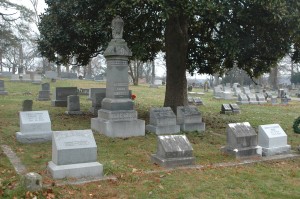
Joseph C.S. Blackburn Family Plot, Frankfort Cemetery: Under the Magnolia Tree sent by the Smithsonian. Photo courtesy of the author.
It was a fitting tribute from the man who had been personally helped by Abraham Lincoln in his first court appearance.
Joseph C. S. Blackburn died in 1918 before the Memorial was completed and dedicated in 1922. He lay in state at the Frankfort Capitol below the feet of the statue of Abraham Lincoln. He is buried in the Frankfort Cemetery beneath a large sheltering Magnolia Tree sent to the Cemetery in his honor by the Smithsonian Institution in Washington, D.C., in recognition of Senator Blackburn’s exceptional work for the city of Washington, D.C.
Elizabeth Rouse Fielder is the 4G Granddaughter of George Blackburn, 3G Granddaughter of Edward Mitchell Blackburn, and 2G Granddaughter of Senator Joseph C. S. Blackburn. Ms. Fielder is from Midway, Kentucky who previously resided at Senator Blackburn’s Farm at Spring Station, Kentucky which is a portion of the original George Blackburn Estate “Equira” where her Grandmother Terese Blackburn Rouse lived and raised her father Owen Conner Rouse Jr. The farm is now owned by another descendant of George Blackburn and has been continuously in the Blackburn family for two hundred and forty-four (244) years and counting. Ms. Fielder is an attorney, developer and consultant to developers of affordable rental housing.
Maj. George Blackburn, in Find A Grave.
http://www.findagrave.com/cgi-bin/fg.cgi?page=gr&GScid=2369568&GRid=58411888&
[ii] William Edward Railey, History of Woodford County, Kentucky, Genealogical Publishing Com., 1938.
[iii] William Edward Railey, History of Woodford County, Kentucky, Genealogical Publishing Com., 1938.
[iv] Elder C. Lewis, History of Big Spring Baptist Church, Woodford County, KY (Now Spring Station), http://baptisthistoryhomepage.com/ky.elkhorn.hist.big.sprgs.html, 1877 (Accessed April 14, 2014).
[v] E. Polk Johnson, A History of Kentucky and Kentuckians: The Leaders and RepresentativeMen in Commerce, Industry and Modern Activities, Vol. II, The Lewis Publishing Company, 1912.
[vi] William Edward Railey, History of Woodford County, Kentucky, Genealogical Publishing Com., 1938.
[vii] “Early History of Midway, Col. E. M. Blackburn,” The Blue Grass Clipper, Vol. LV, No. 34, February 27, 1930.
[viii] Jonelle Fisher, Nantura, 1795-1905, St. Crispin Press, 2004; Jonelle Fisher, For All Times: The Story of Lucas Brodhead, St. Crispin Press, 2002.
[ix] Edward Steers, Blood on the Moon: The Assassination of Abraham Lincoln, University Press of Kentucky, 2001.
[x] Jerome G. Taylor, Kentucky’s Governors, 1792-1985, The Kent State University Press, 1988.
[xi] National Museum of Racing and Hall of Fame, Hall of Fame Horses, (www.racingmuseum.org/hall-of-fame/horses-view.asp?varID=104), Accessed April 14, 2014.
[xii] Buckner Stith Morris,( http://en.wikipedia.org/wiki/Buckner_Stith_Morris), Accessed May 14, 2014.
[xiii] James Tandy Ellis, “Helped Him Out, The Tang of the South,” The Times-Star, March 10, 1932.
free sample just need to mind that the that nix desire vary.




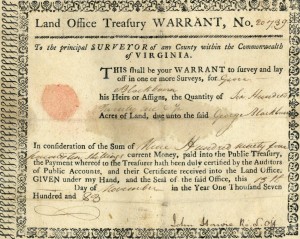
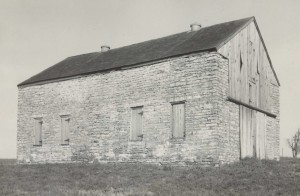
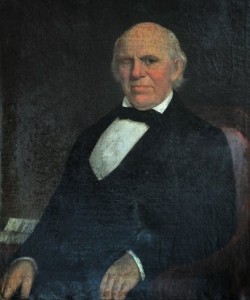
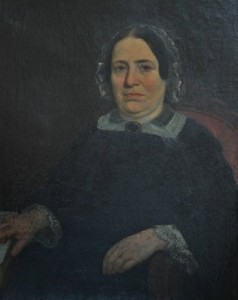
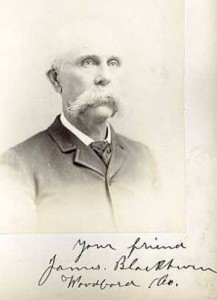
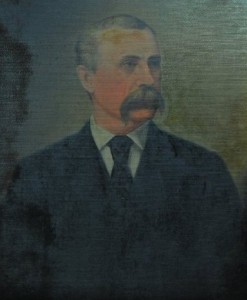
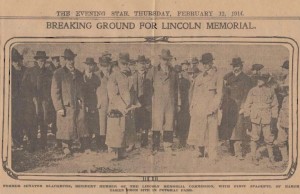
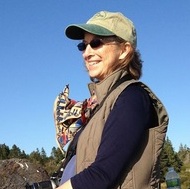

Evelyne Heller
I am a direct Blackburn descendant. My father is Edward Heller. His mother, my grandmother was Henrietta Lyle Blackburn. Her father, My great grandfather was Judge Samuel Blackburn. So my great great grandfather was James W Blackburn.so my great great great grandfather was Uncle Ned Blackburn. And so on.
I have always wanted to learn about my heritage.
Thank you. If you want to know or speak with me. I wouldn’t mind learning more .
Tonya Blackburn Hutchinson
Hello Ms. Evelyne Heller,
I found your information very well put together and thank you for sharing. I’ve been working on researching my line of Blackburn’s which also were from KY. Though as of now I’m not sure if we are from the same group at some time or not. I have been researching some of your family in hopes to find more possible on mine.
My family is mostly from the eastern area of Kentucky and my father was born in Pike Co. KY. I know that we go at least for me four generation back in this basic area. I’m interested in if you know about any lines that are in this part of KY?
Also, I provided my email address though I have to admit that I do not use it hardly at all but if you have a facebook account I’m listed under the name Tonya Blackburn Hutchinson.
I do not know if you also read the Kentucky Explorer but it will provide information on your line of Blackburn which you may enjoy looking up and reading.
I thank you for your time and would really love to learn more about you and your line.
Sincerely,
Tonya Blackburn Hutchinson
Tanya Hurst
My great-grandfather, maternal side, is George Blackburn of Kentucky. He was married to Stella Mae Morrison Blackburn, and they lived in Lexington, Kentucky.